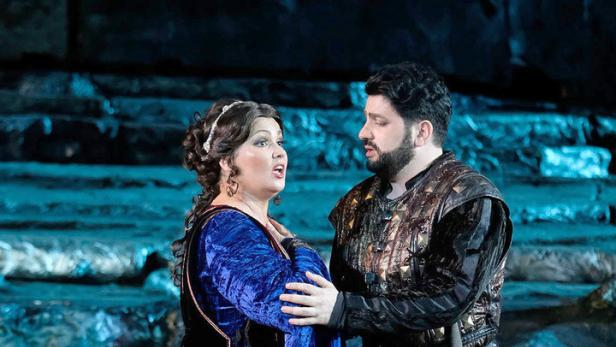IL TROVATORE (Verdi) Arena di Verona 2019 Anna Netrebko, Yusif Eyvazov, Luca Salsi
In this video
WATCH THE FULL VIDEO PERFORMANCE ON STAGE+ (subscription required)
PURCHASE THE BD/DVD FROM AMAZON
IL TROVATORE by Giuseppe Verdi
Arena di Verona, Italy
August 2019
CAST
Leonora: Anna Netrebko
Manrico: Yusif Eyvazov
Count Di Luna: Luca Salsi
Azucena: Dolora Zajick
Ferrando: Riccardo Fassi
Ines: Elisabetta Zizzo
Ruiz: Carlo Bosi
An Old Gipsy: Dario Giorgelè
A Messenger: Antonello Ceron
_________________________________
Conductor: Pier Giorgio Morandi
Orchestra of the Arena di Verona
Chorus of the Arena di Verona
Chorus Master: Vito Lombardi
Ballet of the Arena di Verona
_________________________________
Stage Director: Franco Zeffirelli
Stage Designer: Franco Zeffirelli
Costume Designer: Raimonda Gaetani
Choreographer: Lucia Real after El Camborio
=================================================
Il trovatore (‘The Troubadour’) is an opera in four acts by Giuseppe Verdi to an Italian libretto largely written by Salvadore Cammarano, based on the Spanish play El trovador (1836) by Antonio García Gutiérrez. It was García Gutiérrez’s most successful play, one which Verdi scholar Julian Budden describes as “a high flown, sprawling melodrama flamboyantly defiant of the Aristotelian unities, packed with all manner of fantastic and bizarre incident.”
The premiere took place at the Teatro Apollo in Rome on 19 January 1853, where it “began a victorious march throughout the operatic world”, a success due to Verdi’s work over the previous three years. It began with his January 1850 approach to Cammarano with the idea of Il trovatore. There followed, slowly and with interruptions, the preparation of the libretto, first by Cammarano until his death in mid-1852 and then with the young librettist Leone Emanuele Bardare, which gave the composer the opportunity to propose significant revisions, which were accomplished under his direction.[3] These revisions are seen largely in the expansion of the role of Leonora.
For Verdi, the three years were filled with musical activity; work on this opera did not proceed while the composer wrote and premiered Rigoletto in Venice in March 1851. His personal affairs also limited his professional work. In May 1851, an additional commission was offered by the Venice company after Rigoletto’s success there. Another commission came from Paris while he was visiting that city from late 1851 to March 1852. Before the libretto for Il trovatore was completed, before it was scored, and before it premiered, Verdi had four operatic projects in various stages of development.
Today, Il trovatore is performed frequently and is a staple of the standard operatic repertoire.
Synopsis
Act 1: The Duel
Scene 1: The guard room in the castle of Luna (The Palace of Aljafería, Zaragoza, Spain)
Ferrando, the captain of the guards, orders his men to keep watch while Count di Luna wanders restlessly beneath the windows of Leonora, lady-in-waiting to the Princess. Di Luna loves Leonora and is jealous of his successful rival, a troubadour whose identity he does not know. In order to keep the guards awake, Ferrando narrates the history of the count (Racconto: Di due figli vivea padre beato / “The good Count di Luna lived happily, the father of two sons”): many years ago, a gypsy woman was wrongfully accused of having bewitched the youngest of the di Luna children; the child had fallen sick, and for this the gypsy had been burnt alive as a witch, her protests of innocence ignored. Dying, she had commanded her daughter Azucena to avenge her, which she did by abducting the baby. Although the burnt bones of a child were found in the ashes of the pyre, the father refused to believe his son’s death. Dying, the father commanded his firstborn, the new Count di Luna, to seek Azucena.
Scene 2: Garden in the palace of the princess

Leonora confesses her love for the Troubadour to her confidante, Ines (Cavatina (Tacea la notte placida / “The peaceful night lay silent”… Di tale amor / “A love that words can scarcely describe”), in which she tells how she fell in love with a mystery knight, victor at a tournament; lost track of him when a civil war broke out; then encountered him again, in disguise as a wandering troubadour who sang beneath her window. When they have gone, Count di Luna enters, intending to pay court to Leonora himself, but hears the voice of his rival in the distance: (Deserto sulla terra / “Alone upon this earth”). Leonora in the darkness briefly mistakes the count for her lover, until the Troubadour himself enters the garden, and she rushes to his arms. The Count challenges his rival to reveal his true identity, which he does: Manrico, a knight now outlawed and under death sentence for his allegiance to a rival prince. Manrico in turn challenges him to call the guards, but the Count regards this encounter as a personal rather than political matter, and challenges Manrico instead to a duel over their common love. Leonora tries to intervene, but cannot stop them from fighting (Trio: Di geloso amor sprezzato / “The fire of jealous love” ).
Act 2: The Gypsy Woman
Scene 1: The gypsies’ camp

Manrico realises that he is not the son of Azucena, but loves her as if she were indeed his mother, as she has always been faithful and loving to him – and, indeed, saved his life only recently, discovering him left for dead on a battlefield after being caught in ambush. Manrico tells Azucena that he defeated di Luna in their earlier duel, but was held back from killing him by a mysterious power (Duet: Mal reggendo / “He was helpless under my savage attack”): and Azucena reproaches him for having stayed his hand then, especially since it was the Count’s forces that defeated him in the subsequent battle of Pelilla. A messenger arrives and reports that Manrico’s allies have taken Castle Castellor, which Manrico is ordered to hold in the name of his prince: and also that Leonora, who believes Manrico dead, is about to enter a convent and take the veil that night. Although Azucena tries to prevent him from leaving in his weak state (Ferma! Son io che parlo a te! / “I must talk to you”), Manrico rushes away to prevent her from carrying out this intent.
Scene 2: In front of the convent
Di Luna and his attendants intend to abduct Leonora and the Count sings of his love for her (Aria: Il balen del suo sorriso / “The light of her smile” … Per me ora fatale / “Fatal hour of my life”). Leonora and the nuns appear in procession, but Manrico prevents di Luna from carrying out his plans and takes Leonora away with him, although once again leaving the Count behind unharmed, as the soldiers on both sides back down from bloodshed, the Count being held back by his own men.
Act 3: The Son of the Gypsy Woman

Scene 1: Di Luna’s camp
Di Luna and his army are attacking the fortress Castellor where Manrico has taken refuge with Leonora (Chorus: Or co’ dadi ma fra poco / “Now we play at dice”). Ferrando drags in Azucena, who has been captured wandering near the camp. When she hears di Luna’s name, Azucena’s reactions arouse suspicion and Ferrando recognizes her as the supposed murderer of the count’s brother. Azucena cries out to her son Manrico to rescue her and the count realizes that he has the means to flush his enemy out of the fortress. He orders his men to build a pyre and burn Azucena before the walls.
Scene 2: A chamber in the castle
Inside the castle, Manrico and Leonora are preparing to be married. She is frightened; the battle with di Luna is imminent and Manrico’s forces are outnumbered. He assures her of his love (Aria: Ah sì, ben mio, coll’essere / “Ah, yes, my love, in being yours”), even in the face of death. When news of Azucena’s capture reaches him, he summons his men and desperately prepares to attack (Cabaletta: Di quella pira l’orrendo foco / “The horrid flames of that pyre”). Leonora faints.
Act 4: The Punishment
Scene 1: Before the dungeon keep
Manrico has failed to free Azucena and has been imprisoned himself. Leonora attempts to free him (Aria: D’amor sull’ali rosee / “On the rosy wings of love”; Chorus & Duet: Miserere / “Lord, thy mercy on this soul”) by begging di Luna for mercy and offers herself in place of her lover. She promises to give herself to the Count, but secretly swallows poison from her ring in order to die before di Luna can possess her (Duet: Mira, d’acerbe lagrime / “See the bitter tears I shed”).
Scene 2: In the dungeon
Quoted from Wikipedia







